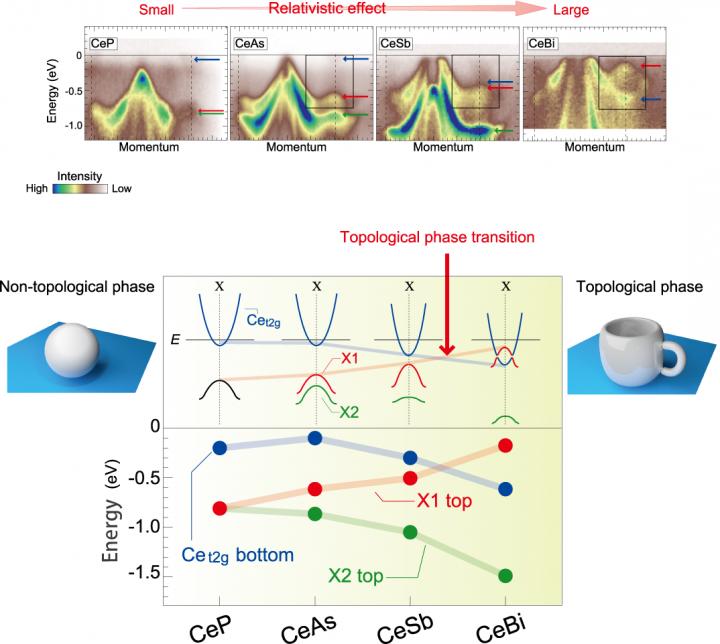Direct observation of topology hidden inside materials

These are electronic structures of Ce monopnictides which observed by soft X-ray angle-resolved photoemission spectroscopy, and its topological phase transition. Credit: © 2018 Kenta Kuroda
Topology hidden inside materials in the matter group called cerium monopnictides has been determined for the first time in the world.
The topological electronic phase distinguished by the latent topology inside materials is the award-winning subject of the Nobel Prize in Physics 2016, research on which is now being actively conducted all over the world.
In the topological electronic phase, an electronic state peculiar to the topological electronic phase occurs at the surface of materials (appearance), reflecting topology hidden inside materials (substances). For this reason, topology of a substance has been judged only by its appearance.
A joint research group succeeded in observing the topological phase transition in which a material changes to the topological electronic phase by using soft X-rays, light suitable for determining the topology of materials by their substances rather than by their appearance.
Since this research achievement enables direct determination of the essential topology hidden inside materials without judging the surface of the materials, it is expected that employing this technique will lead to the discovery of more diverse topological electronic phases.
###
This result was achieved by the research group of Assistant Professor Kenta Kuroda and Associate Professor Takeshi Kondo of the Institute for Solid State Physics, the University of Tokyo (Director Masashi Takigawa), in collaboration with Team Leader Ryotaro Arita (RIKEN Center for Emergent Matter Science), Assistant Professor Masayuki Ochi (the Graduate School of Science, Osaka University), Senior Scientist Takayuki Muro (Japan Synchrotron Radiation Research Institute), Deputy Director-General Hideyuki Kitazawa (National Institute for Materials Science) and Principle Researcher Yoshinori Haga (Japan Atomic Energy Agency).
Osaka University was founded in 1931 as one of the seven imperial universities of Japan and now has expanded to one of Japan's leading comprehensive universities. The University has now embarked on open research revolution from a position as Japan's most innovative university and among the most innovative institutions in the world according to Reuters 2015 Top 100 Innovative Universities and the Nature Index Innovation 2017. The university's ability to innovate from the stage of fundamental research through the creation of useful technology with economic impact stems from its broad disciplinary spectrum.
Website: http://resou.
Media Contact
All latest news from the category: Materials Sciences
Materials management deals with the research, development, manufacturing and processing of raw and industrial materials. Key aspects here are biological and medical issues, which play an increasingly important role in this field.
innovations-report offers in-depth articles related to the development and application of materials and the structure and properties of new materials.
Newest articles

High-energy-density aqueous battery based on halogen multi-electron transfer
Traditional non-aqueous lithium-ion batteries have a high energy density, but their safety is compromised due to the flammable organic electrolytes they utilize. Aqueous batteries use water as the solvent for…

First-ever combined heart pump and pig kidney transplant
…gives new hope to patient with terminal illness. Surgeons at NYU Langone Health performed the first-ever combined mechanical heart pump and gene-edited pig kidney transplant surgery in a 54-year-old woman…

Biophysics: Testing how well biomarkers work
LMU researchers have developed a method to determine how reliably target proteins can be labeled using super-resolution fluorescence microscopy. Modern microscopy techniques make it possible to examine the inner workings…





















